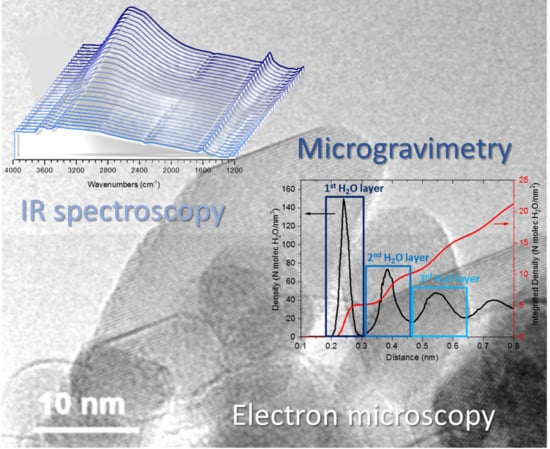Morphology, Surface Structure and Water Adsorption Properties of TiO2 Nanoparticles: A Comparison of Different Commercial Samples
Abstract
1. Introduction
2. Results and Discussion
2.1. Particle Morphology and Surface Structure
2.2. MIR Spectra of Adsorbed H2O
2.3. NIR Spectra of Adsorbed H2O
2.4. Determination of Adsorbed H2O by Microgravimetry
3. Materials and Methods
3.1. Materials and Preliminary Characterization
3.2. Microgravimetry
3.3. Mid-IR (FTIR) Spectroscopy
3.4. Near IR Spectroscopy
4. Conclusions
Author Contributions
Funding
Acknowledgments
Conflicts of Interest
References
- Chen, X.; Mao, S.S. Titanium dioxide nanomaterials: Synthesis, properties, modifications and applications. Chem. Rev. 2007, 107, 2891–2959. [Google Scholar] [CrossRef] [PubMed]
- Sun, C.; Liu, L.-M.; Selloni, A.; Lu, G.Q.; Smith, S.C. Titania-water interactions: A review of theoretical studies. J. Mater. Chem. 2010, 20, 10319–10334. [Google Scholar] [CrossRef]
- Mino, L.; Ferrari, A.M.; Lacivita, V.; Spoto, G.; Bordiga, S.; Zecchina, A. CO Adsorption on anatase nanocrystals: A combined experimental and periodic DFT study. J. Phys. Chem. C 2011, 115, 7694–7700. [Google Scholar] [CrossRef]
- Setvin, M.; Daniel, B.; Aschauer, U.; Hou, W.; Li, Y.F.; Schmid, M.; Selloni, A.; Diebold, U. Identification of adsorbed molecules via STM tip manipulation: CO, H2O, and O2 on TiO2 anatase (101). Phys. Chem. Chem. Phys. 2014, 16, 21524–21530. [Google Scholar] [CrossRef] [PubMed]
- Dette, C.; Perez-Osorio, M.A.; Mangel, S.; Giustino, F.; Jung, S.J.; Kern, K. Single-molecule vibrational spectroscopy of H2O on anatase TiO2(101). J. Phys. Chem. C 2017, 121, 1182–1187. [Google Scholar] [CrossRef]
- Herman, G.S.; Dohnalek, Z.; Ruzycki, N.; Diebold, U. Experimental investigation of the interaction of water and methanol with anatase-TiO2(101). J. Phys. Chem. B 2003, 107, 2788–2795. [Google Scholar] [CrossRef]
- Nadeem, I.M.; Treacy, J.P.W.; Selcuk, S.; Torrelles, X.; Hussain, H.; Wilson, A.; Grinter, D.C.; Cabailh, G.; Bikondoa, O.; Nicklin, C.; et al. Water dissociates at the aqueous interface with reduced anatase TiO2 (101). J. Phys. Chem. Lett. 2018, 9, 3131–3136. [Google Scholar] [CrossRef]
- Blomquist, J.; Walle, L.E.; Uvdal, P.; Borg, A.; Sandell, A. Water dissociation on single crystalline anatase TiO2(001) studied by photoelectron spectroscopy. J. Phys. Chem. C 2008, 112, 16616–16621. [Google Scholar] [CrossRef]
- Andrade, M.F.C.; Ko, H.Y.; Car, R.; Selloni, A. Structure, polarization, and sum frequency generation spectrum of interfacial water on anatase TiO2. J. Phys. Chem. Lett. 2018, 9, 6716–6721. [Google Scholar] [CrossRef]
- Cazzaniga, M.; Micciarelli, M.; Moriggi, F.; Mahmoud, A.; Gabas, F.; Ceotto, M. Anharmonic calculations of vibrational spectra for molecular adsorbates: A divide-and-conquer semiclassical molecular dynamics approach. J. Chem. Phys. 2020, 152, 13. [Google Scholar] [CrossRef]
- Mino, L.; Pellegrino, F.; Rades, S.; Radnik, J.; Hodoroaba, V.D.; Spoto, G.; Maurino, V.; Martra, G. Beyond shape engineering of TiO2 nanoparticles: Post-synthesis treatment dependence of surface hydration, hydroxylation, lewis acidity; photocatalytic activity of TiO2 anatase nanoparticles with dominant {001} or {101} facets. Acs Appl. Nano Mater. 2018, 1, 5355–5365. [Google Scholar] [CrossRef]
- Nosaka, A.Y.; Nishino, J.; Fujiwara, T.; Ikegami, T.; Yagi, H.; Akutsu, H.; Nosaka, Y. Effects of thermal treatments on the recovery of adsorbed water; photocatalytic activities of TiO2 photocatalytic systems. J. Phys. Chem. B 2006, 110, 8380–8385. [Google Scholar] [CrossRef] [PubMed]
- Mino, L.; Zecchina, A.; Martra, G.; Rossi, A.M.; Spoto, G. A surface science approach to TiO2 P25 photocatalysis: An in situ FTIR study of phenol photodegradation at controlled water coverages from sub-monolayer to multilayer. Appl. Catal. B-Environ. 2016, 196, 135–141. [Google Scholar] [CrossRef]
- Mino, L.; Negri, C.; Zecchina, A.; Spoto, G. Photodegradation of organic pollutants on TiO2 P25 surfaces investigated by transmission FTIR spectroscopy under in situ UV-Vis irradiation. Z. Phys. Chem. 2016, 230, 1441–1451. [Google Scholar] [CrossRef]
- Hadjiivanov, K.I.; Klissurski, D.G. Surface chemistry of titania (anatase) and titania-supported catalysts. Chem. Soc. Rev. 1996, 25, 61–69. [Google Scholar] [CrossRef]
- Woll, C. Structure and chemical properties of oxide nanoparticles determined by surface-ligand IR spectroscopy. ACSs Catal. 2020, 10, 168–176. [Google Scholar] [CrossRef]
- Lin, H.X.; Long, J.L.; Gu, Q.; Zhang, W.X.; Ruan, R.S.; Li, Z.H.; Wang, X.X. In situ IR study of surface hydroxyl species of dehydrated TiO2: Towards understanding pivotal surface processes of TiO2 photocatalytic oxidation of toluene. Phys. Chem. Chem. Phys. 2012, 14, 9468–9474. [Google Scholar] [CrossRef]
- Szczepankiewicz, S.H.; Colussi, A.J.; Hoffmann, M.R. Infrared spectra of photoinduced species on hydroxylated titania surfaces. J. Phys. Chem. B 2000, 104, 9842–9850. [Google Scholar] [CrossRef]
- Mino, L.; Cesano, F.; Scarano, D.; Spoto, G.; Martra, G. Molecules and heterostructures at TiO2 surface: The cases of H2O, CO2, and organic and inorganic sensitizers. Res. Chem. Intermed. 2019, 45, 5801–5829. [Google Scholar] [CrossRef]
- Mandavi-Shakib, A.; Arce-Ramos, J.M.; Austin, R.N.; Schwartz, T.J.; Grabow, L.C.; Frederick, B.G. Frequencies and thermal stability of isolated surface hydroxyls on pyrogenic TiO2 nanoparticles. J. Phys. Chem. C 2019, 123, 24533–24548. [Google Scholar] [CrossRef]
- Mino, L. IR spectroscopy as a tool to investigate photocatalytic reactions at oxide surfaces. Rend. Lincei.-Sci. Fis. Nat. 2017, 28, 143–149. [Google Scholar] [CrossRef]
- Schnee, J.; Daturi, M.; El-Roz, M. Ultrafast time-resolved quantum cascade laser diagnostic for revealing the role of surface formate species in the photocatalytic oxidation of methanol. Catal. Sci. Technol. 2020, 10, 5618–5627. [Google Scholar] [CrossRef]
- Subbotina, I.R.; Barsukov, D.V. Direct evidence of the key role of UV-formed peroxide species in photocatalytic gas-solid oxidation in air on anatase TiO2 particles. Phys. Chem. Chem. Phys. 2020, 22, 2200–2211. [Google Scholar] [CrossRef] [PubMed]
- Gordon, T.R.; Cargnello, M.; Paik, T.; Mangolini, F.; Weber, R.T.; Fornasiero, P.; Murray, C.B. Nonaqueous synthesis of TiO2 nanocrystals using TiF4 to engineer morphology, oxygen vacancy concentration, and photocatalytic activity. J. Am. Chem. Soc. 2012, 134, 6751–6761. [Google Scholar] [CrossRef] [PubMed]
- Pellegrino, F.; Sordello, F.; Mino, L.; Minero, C.; Hodoroaba, V.D.; Martra, G.; Maurino, V. Formic acid photoreforming for hydrogen production on shape-controlled anatase TiO2 nanoparticles: Assessment of the role of fluorides, {101}/{001} surfaces ratio, and platinization. ACS Catal. 2019, 9, 6692–6697. [Google Scholar] [CrossRef]
- Deiana, C.; Minella, M.; Tabacchi, G.; Maurino, V.; Fois, E.; Martra, G. Shape-controlled TiO2 nanoparticles and TiO2 P25 interacting with CO and H2O2 molecular probes: A synergic approach for surface structure recognition and physico-chemical understanding. Phys. Chem. Chem. Phys. 2013, 15, 307–315. [Google Scholar] [CrossRef]
- Xu, M.C.; Gao, Y.K.; Moreno, E.M.; Kunst, M.; Muhler, M.; Wang, Y.M.; Idriss, H.; Woll, C. Photocatalytic activity of bulk TiO2 anatase and rutile single crystals using infrared absorption spectroscopy. Phys. Rev. Lett. 2011, 106, 4. [Google Scholar] [CrossRef]
- Setvin, M.; Buchholz, M.; Hou, W.Y.; Zhang, C.; Stoger, B.; Hulva, J.; Simschitz, T.; Shi, X.; Pavelec, J.; Parkinson, G.S.; et al. A multitechnique study of CO adsorption on the TiO2 anatase (101) surface. J. Phys. Chem. C 2015, 119, 21044–21052. [Google Scholar] [CrossRef]
- Mino, L.; Spoto, G.; Bordiga, S.; Zecchina, A. Particles morphology and surface properties as investigated by HRTEM, FTIR, and Periodic DFT calculations: From pyrogenic TiO2 (P25) to nanoanatase. J. Phys. Chem. C 2012, 116, 17008–17018. [Google Scholar] [CrossRef]
- Mino, L.; Spoto, G.; Bordiga, S.; Zecchina, A. Rutile surface properties beyond the single crystal approach: New insights from the experimental investigation of different polycrystalline samples and periodic DFT calculations. J. Phys. Chem. C 2013, 117, 11186–11196. [Google Scholar] [CrossRef]
- Takeuchi, M.; Martra, G.; Coluccia, S.; Anpo, M. Investigations of the structure of H2O clusters adsorbed on TiO2 surfaces by near-infrared absorption spectroscopy. J. Phys. Chem. B 2005, 109, 7387–7391. [Google Scholar] [CrossRef] [PubMed]
- Deiana, C.; Fois, E.; Coluccia, S.; Martra, G. Surface structure of TiO2 P25 nanoparticles: Infrared study of hydroxy groups on coordinative defect sites. J. Phys. Chem. C 2010, 114, 21531–21538. [Google Scholar] [CrossRef]
- Finnie, K.S.; Cassidy, D.J.; Bartlett, J.R.; Woolfrey, J.L. IR spectroscopy of surface water and hydroxyl species on nanocrystalline TiO2 films. Langmuir 2001, 17, 816–820. [Google Scholar] [CrossRef]
- Takeuchi, M.; Martra, G.; Coluccia, S.; Anpo, M. Evaluation of the adsorption states of H2O on oxide surfaces by vibrational absorption: Near- and mid-infrared spectroscopy. J. Near Infrared Spectrosc. 2009, 17, 373–384. [Google Scholar] [CrossRef]
- Kavathekar, R.S.; Dev, P.; English, N.J.; MacElroy, J.M.D. Molecular dynamics study of water in contact with the TiO2 rutile-110, 100, 101, 001 and anatase-101, 001 surface. Mol. Phys. 2011, 109, 1649–1656. [Google Scholar] [CrossRef]
- English, N.J. Diffusivity and mobility of adsorbed water layers at TiO2 rutile and anatase interfaces. Crystals 2016, 6, 1. [Google Scholar] [CrossRef]
Sample Availability: Samples of the compounds are available from the authors. |
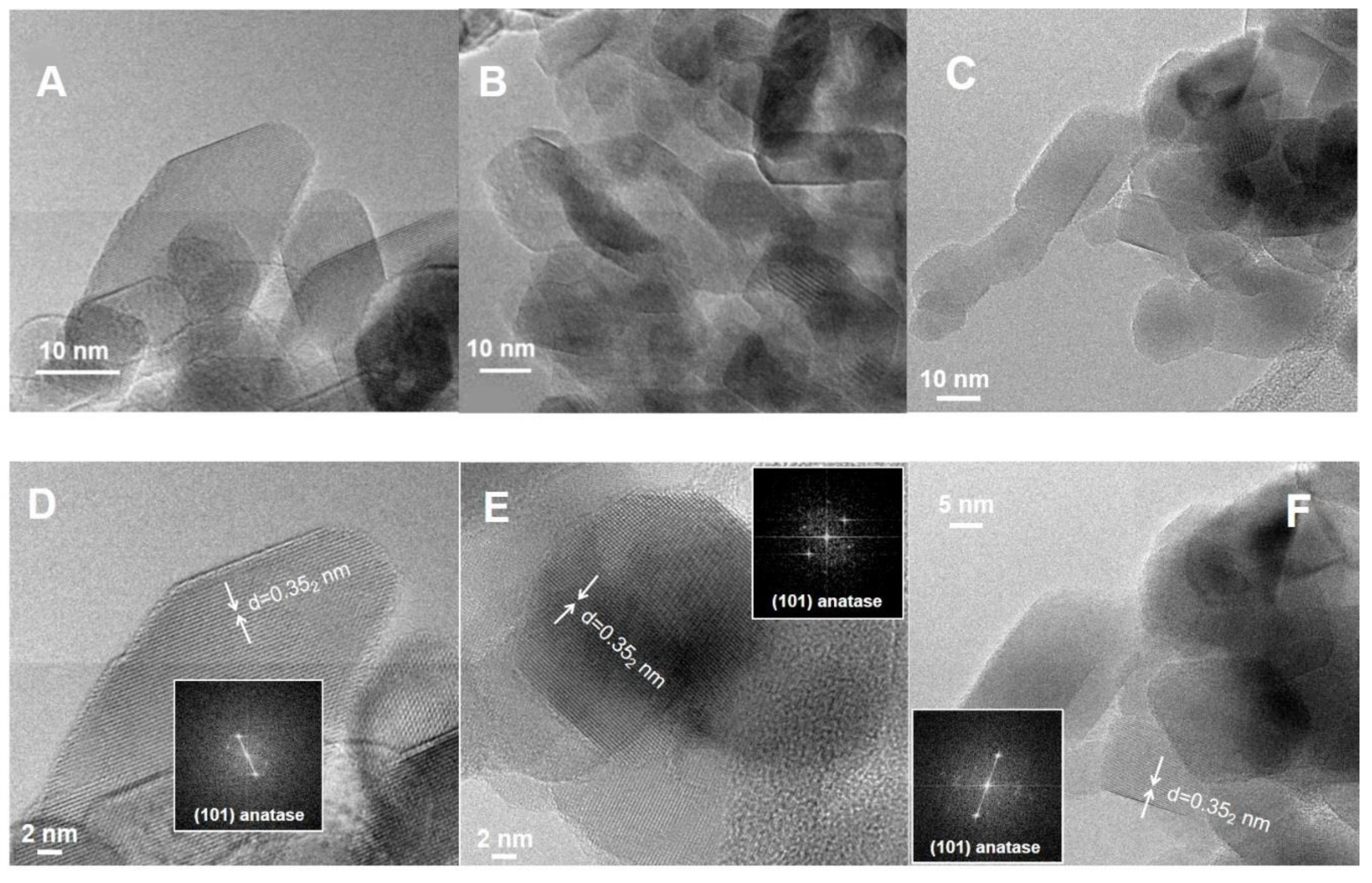
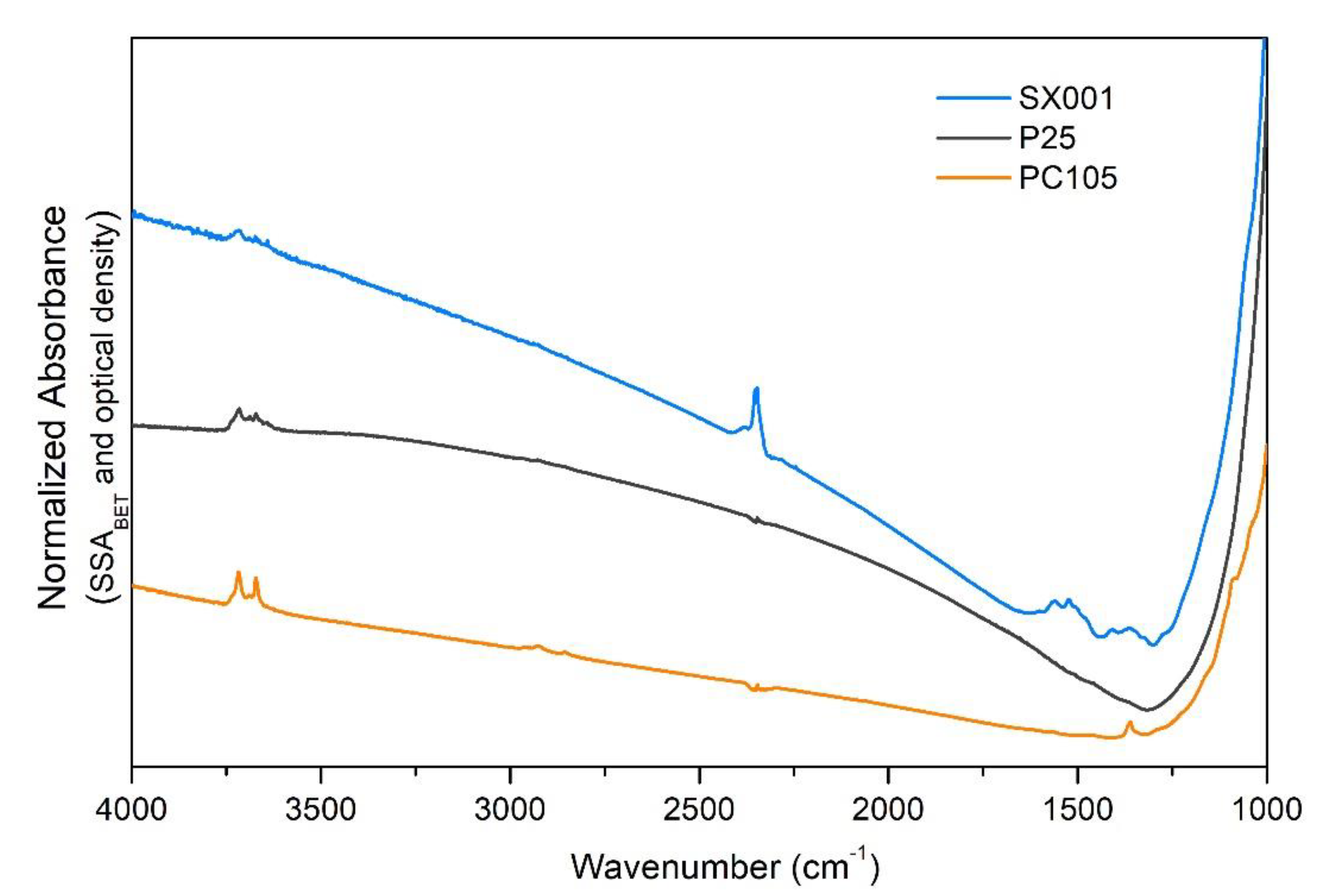
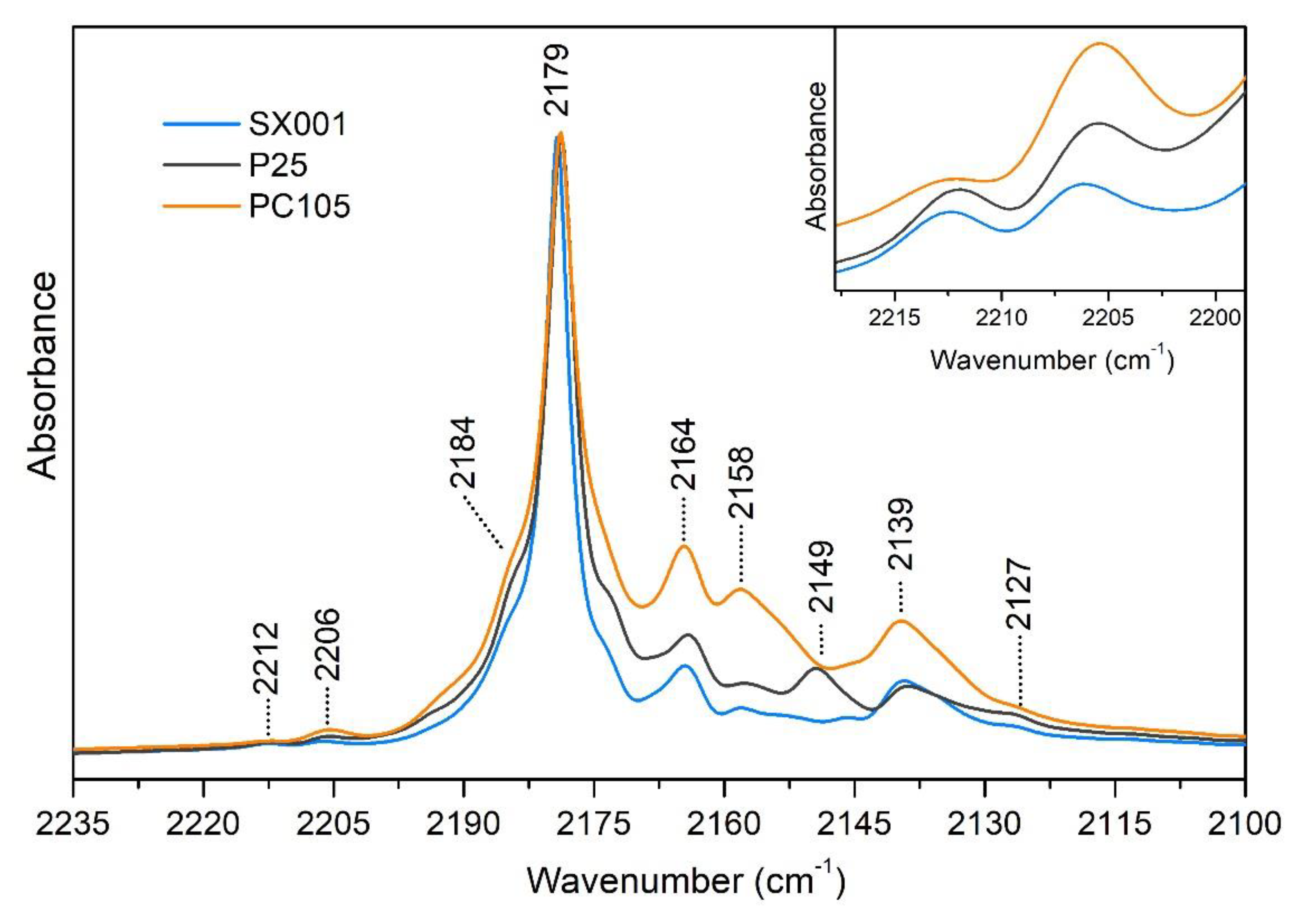

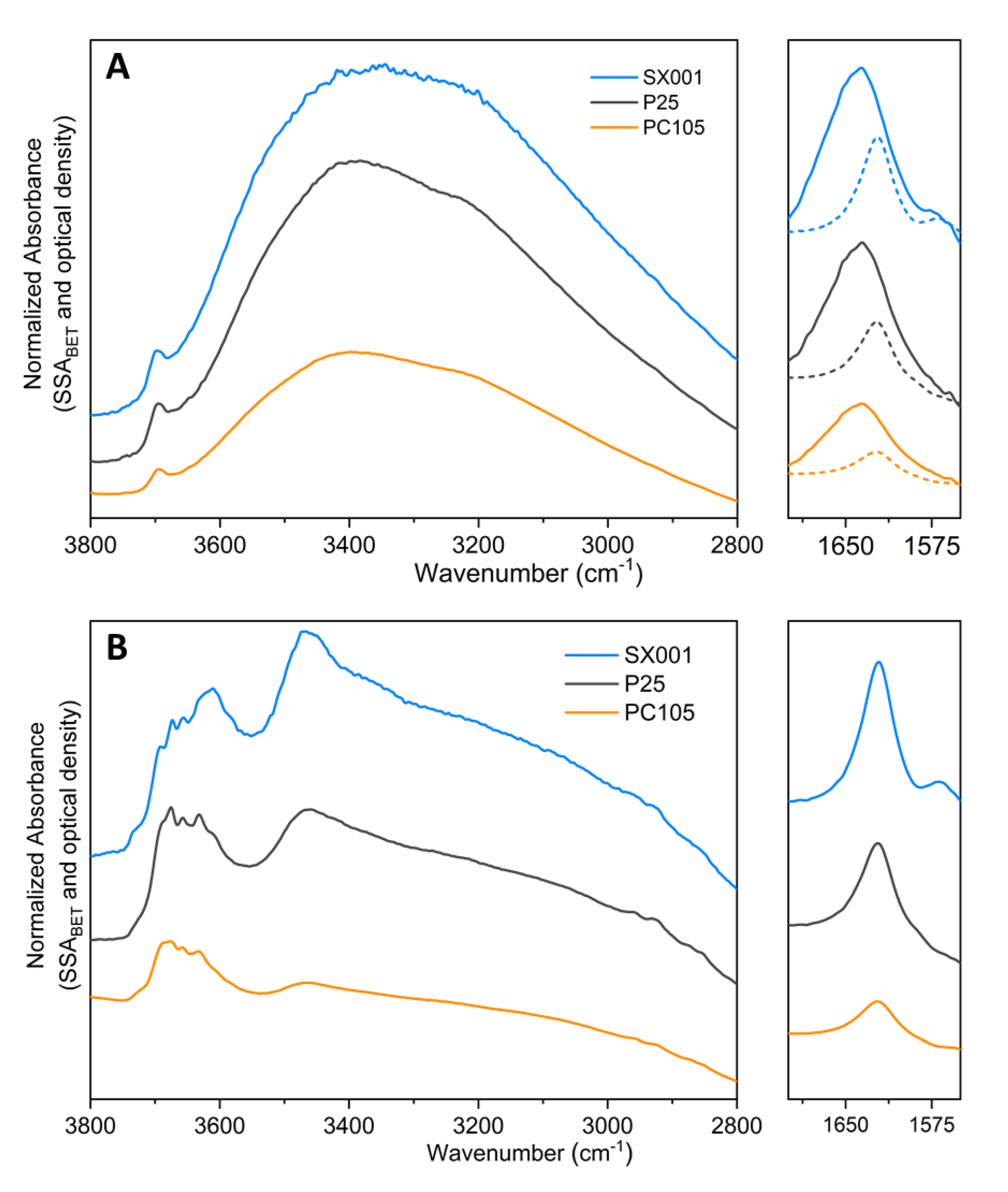
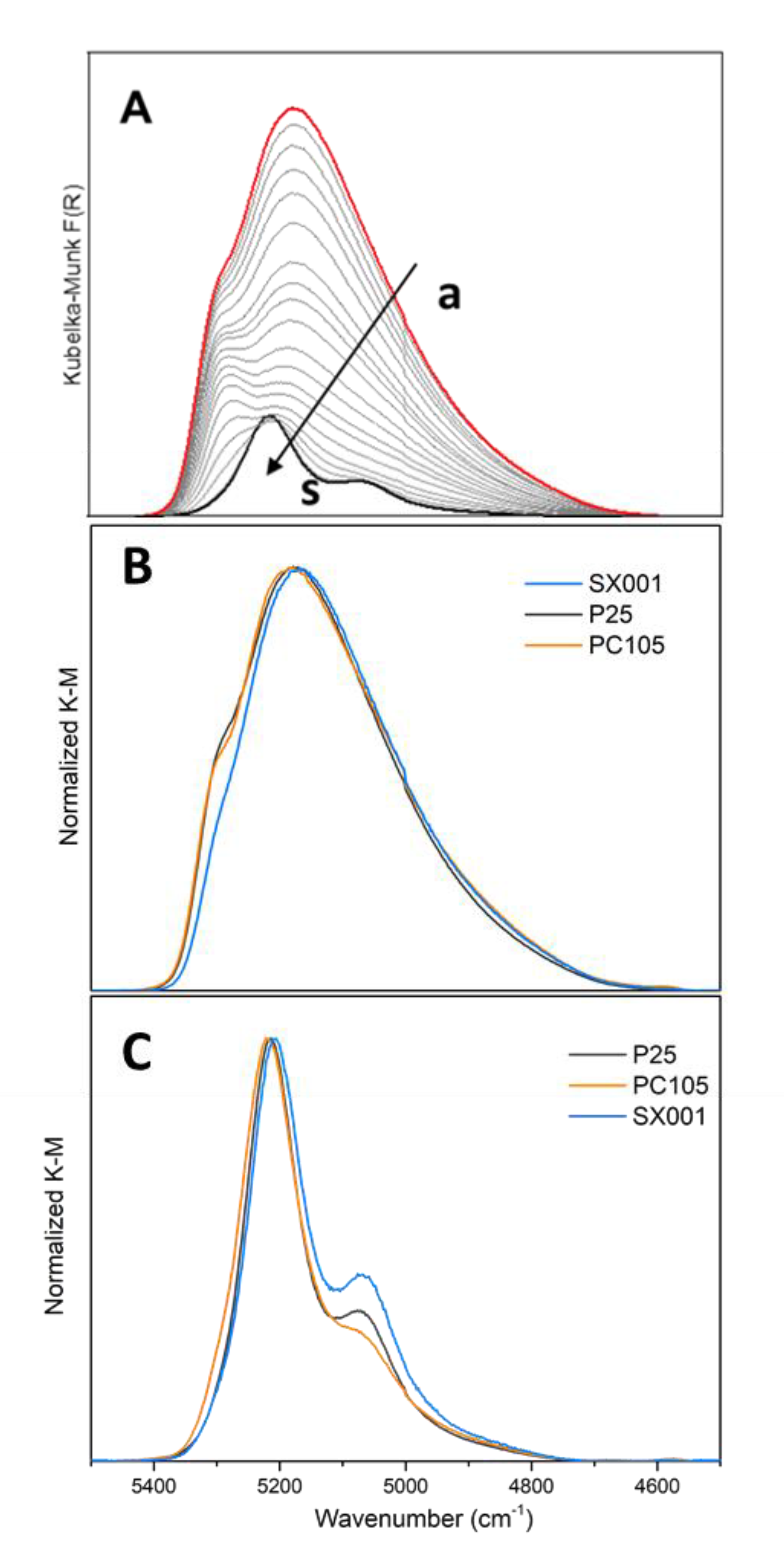
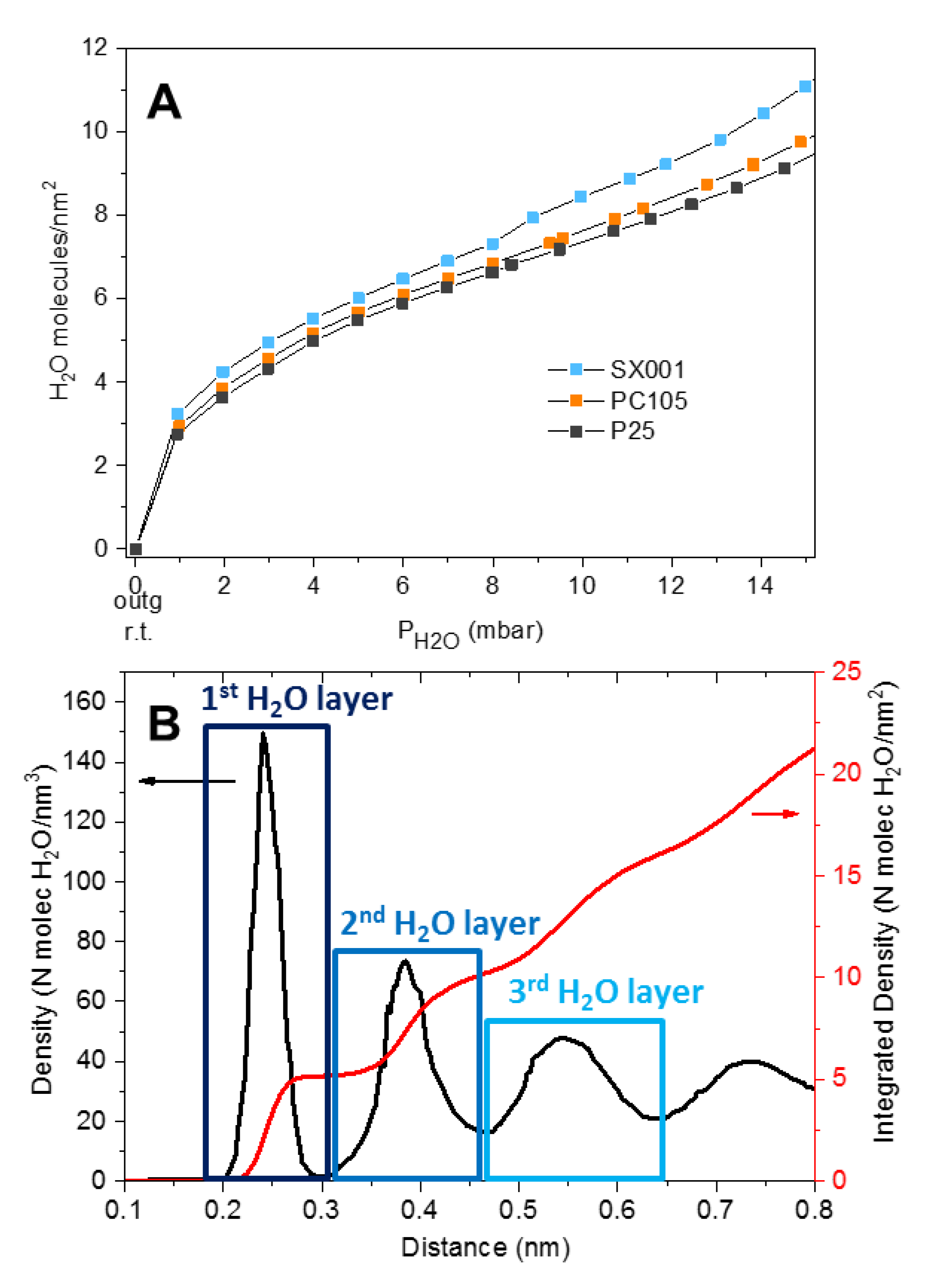
© 2020 by the authors. Licensee MDPI, Basel, Switzerland. This article is an open access article distributed under the terms and conditions of the Creative Commons Attribution (CC BY) license (http://creativecommons.org/licenses/by/4.0/).
Share and Cite
Mino, L.; Negri, C.; Santalucia, R.; Cerrato, G.; Spoto, G.; Martra, G. Morphology, Surface Structure and Water Adsorption Properties of TiO2 Nanoparticles: A Comparison of Different Commercial Samples. Molecules 2020, 25, 4605. https://doi.org/10.3390/molecules25204605
Mino L, Negri C, Santalucia R, Cerrato G, Spoto G, Martra G. Morphology, Surface Structure and Water Adsorption Properties of TiO2 Nanoparticles: A Comparison of Different Commercial Samples. Molecules. 2020; 25(20):4605. https://doi.org/10.3390/molecules25204605
Chicago/Turabian StyleMino, Lorenzo, Chiara Negri, Rosangela Santalucia, Giuseppina Cerrato, Giuseppe Spoto, and Gianmario Martra. 2020. "Morphology, Surface Structure and Water Adsorption Properties of TiO2 Nanoparticles: A Comparison of Different Commercial Samples" Molecules 25, no. 20: 4605. https://doi.org/10.3390/molecules25204605
APA StyleMino, L., Negri, C., Santalucia, R., Cerrato, G., Spoto, G., & Martra, G. (2020). Morphology, Surface Structure and Water Adsorption Properties of TiO2 Nanoparticles: A Comparison of Different Commercial Samples. Molecules, 25(20), 4605. https://doi.org/10.3390/molecules25204605








